Leadership and Management Impact on Tesco's Operational Success
VerifiedAdded on 2024/05/30
|20
|4850
|430
Report
AI Summary
This report provides an in-depth analysis of leadership and management roles within Tesco's business operations. It differentiates between the functions of a leader and a manager, using examples from Tesco to illustrate key characteristics and responsibilities. The study examines the application of leadership and management in various situational contexts, including stable, slow-to-moderate changing, and fast-changing environments. It also explores different leadership theories and models, such as situational leadership and systems leadership, and their relevance to Tesco's operational strategies. The report further assesses the impact of the business environment on operational management and decision-making by leaders and managers within Tesco, highlighting the importance of operations management in achieving overall business objectives. The analysis includes a review of Tesco's management hierarchy and corporate structure, emphasizing the significance of effective leadership and management in maintaining a competitive edge in the retail industry. Desklib offers a range of study tools and solved assignments to support students in their learning journey.
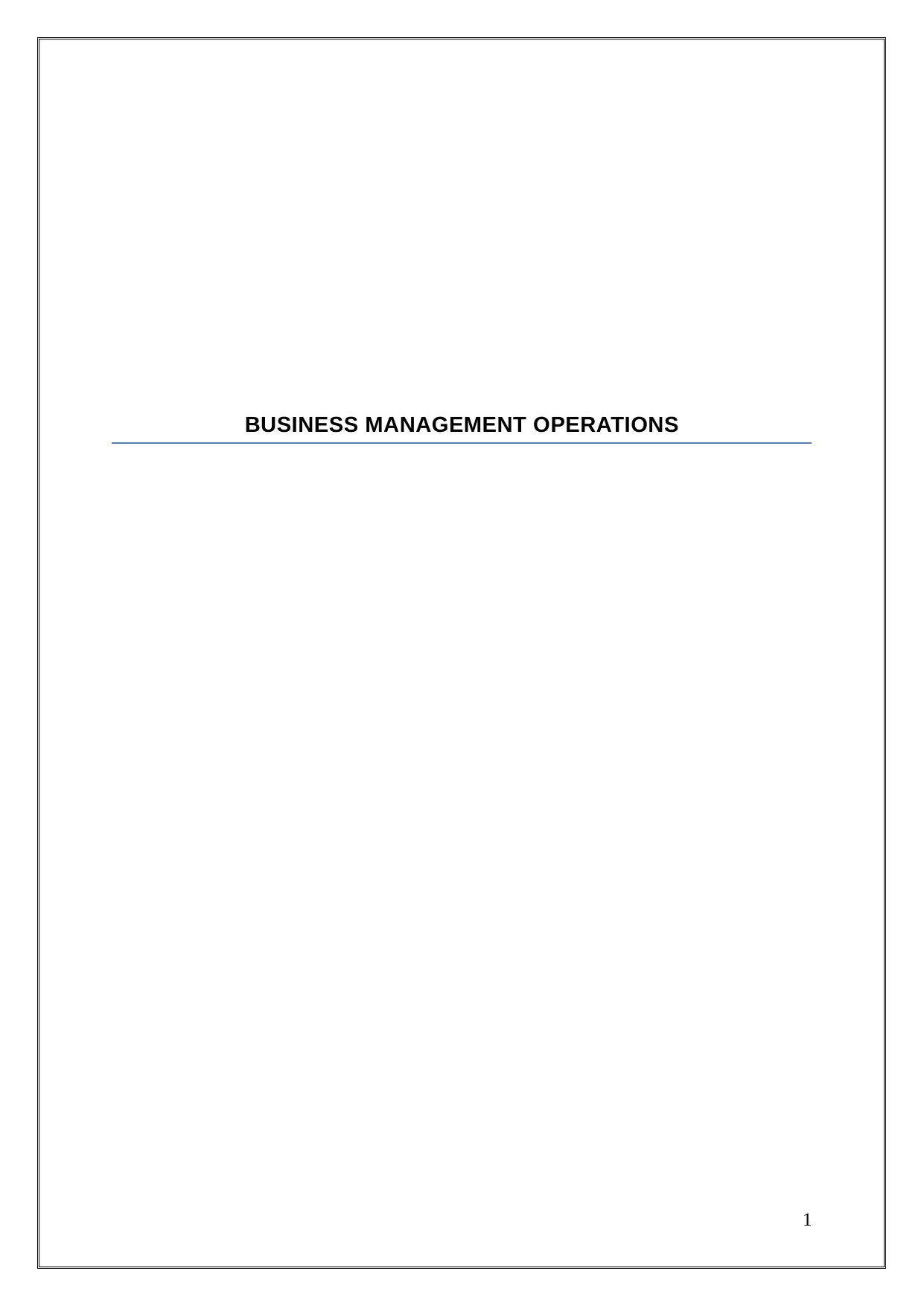
BUSINESS MANAGEMENT OPERATIONS
1
1
Paraphrase This Document
Need a fresh take? Get an instant paraphrase of this document with our AI Paraphraser
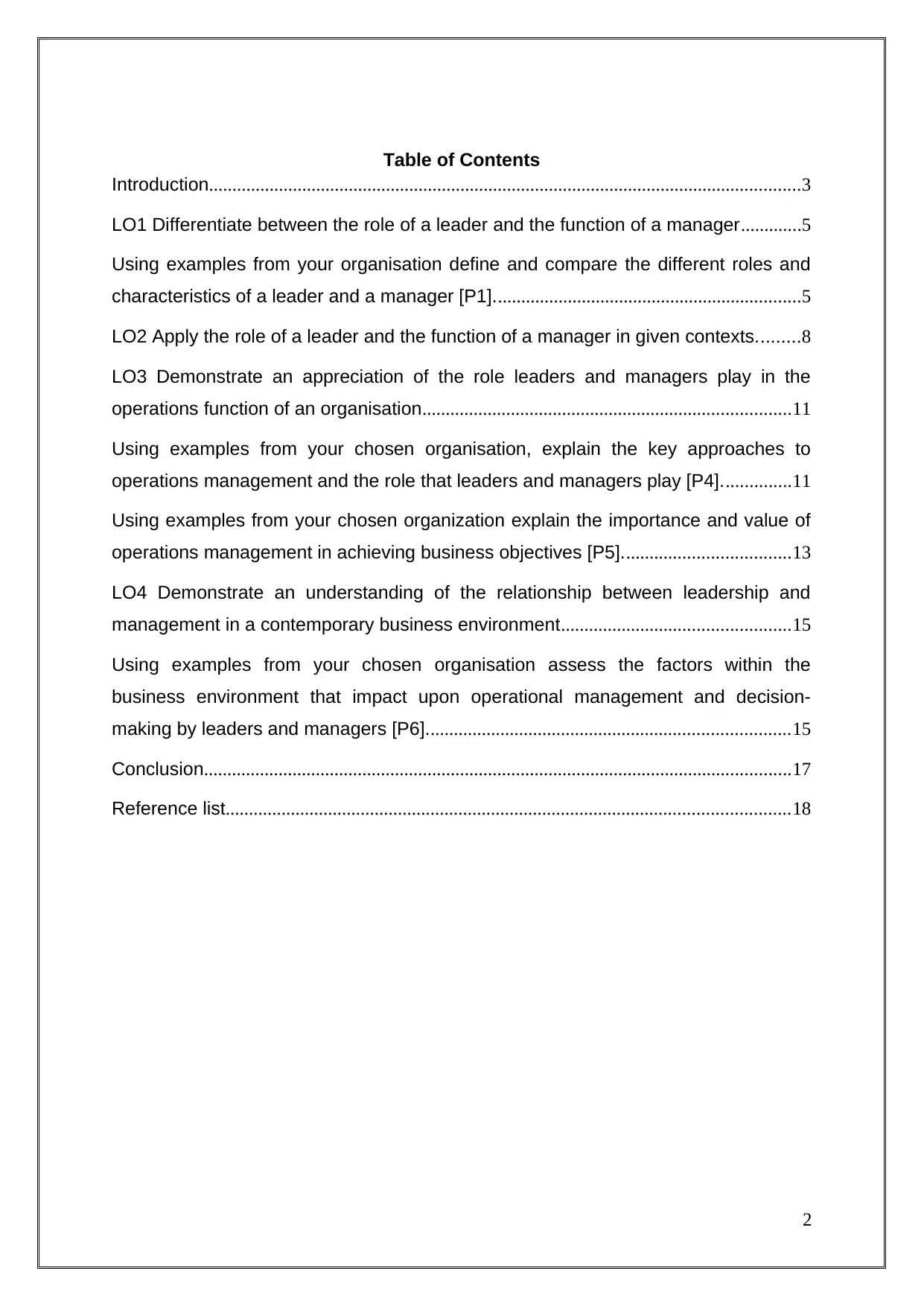
Table of Contents
Introduction...............................................................................................................................3
LO1 Differentiate between the role of a leader and the function of a manager.............5
Using examples from your organisation define and compare the different roles and
characteristics of a leader and a manager [P1]..................................................................5
LO2 Apply the role of a leader and the function of a manager in given contexts.........8
LO3 Demonstrate an appreciation of the role leaders and managers play in the
operations function of an organisation...............................................................................11
Using examples from your chosen organisation, explain the key approaches to
operations management and the role that leaders and managers play [P4]...............11
Using examples from your chosen organization explain the importance and value of
operations management in achieving business objectives [P5]....................................13
LO4 Demonstrate an understanding of the relationship between leadership and
management in a contemporary business environment.................................................15
Using examples from your chosen organisation assess the factors within the
business environment that impact upon operational management and decision-
making by leaders and managers [P6]..............................................................................15
Conclusion..............................................................................................................................17
Reference list.........................................................................................................................18
2
Introduction...............................................................................................................................3
LO1 Differentiate between the role of a leader and the function of a manager.............5
Using examples from your organisation define and compare the different roles and
characteristics of a leader and a manager [P1]..................................................................5
LO2 Apply the role of a leader and the function of a manager in given contexts.........8
LO3 Demonstrate an appreciation of the role leaders and managers play in the
operations function of an organisation...............................................................................11
Using examples from your chosen organisation, explain the key approaches to
operations management and the role that leaders and managers play [P4]...............11
Using examples from your chosen organization explain the importance and value of
operations management in achieving business objectives [P5]....................................13
LO4 Demonstrate an understanding of the relationship between leadership and
management in a contemporary business environment.................................................15
Using examples from your chosen organisation assess the factors within the
business environment that impact upon operational management and decision-
making by leaders and managers [P6]..............................................................................15
Conclusion..............................................................................................................................17
Reference list.........................................................................................................................18
2
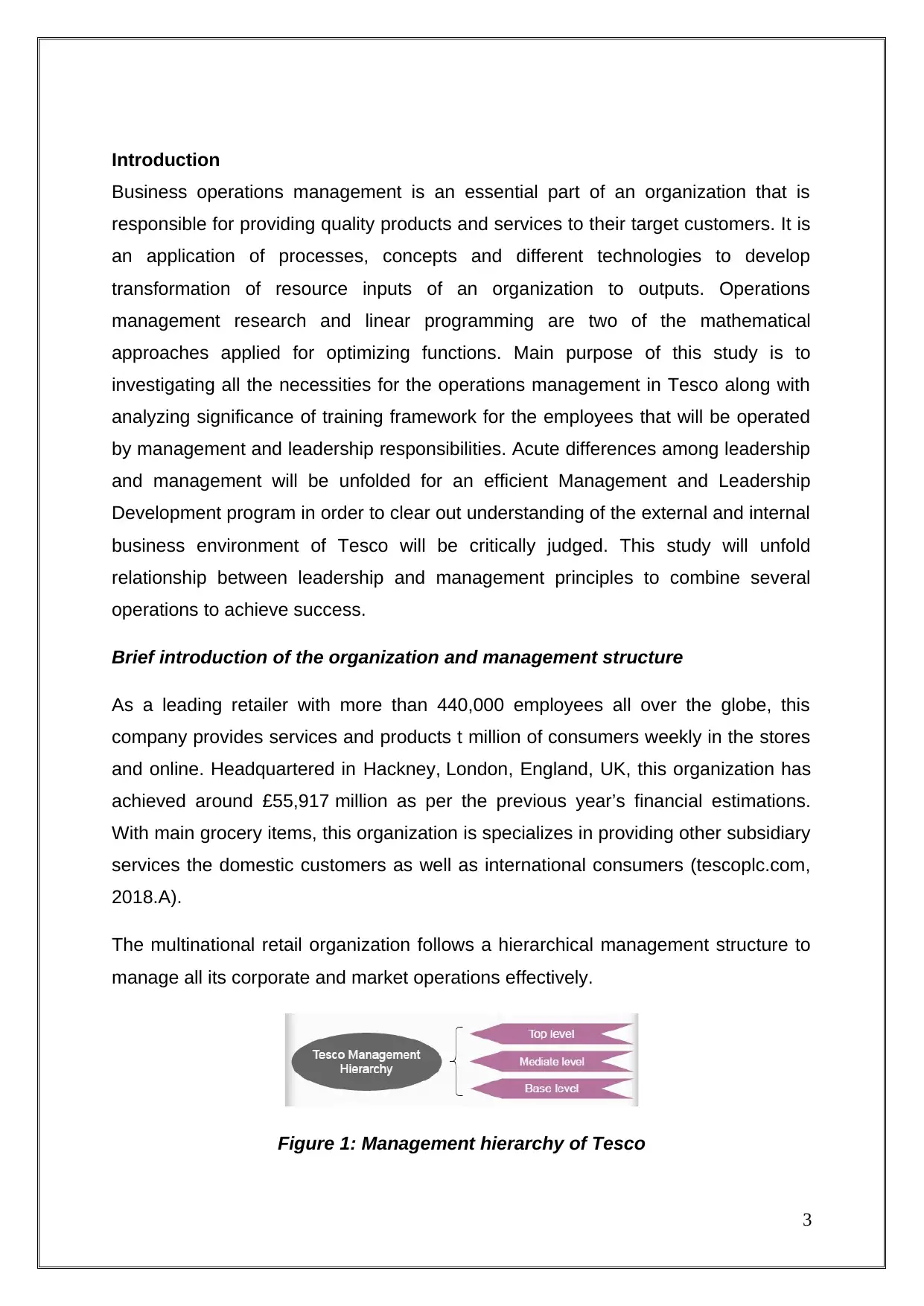
Introduction
Business operations management is an essential part of an organization that is
responsible for providing quality products and services to their target customers. It is
an application of processes, concepts and different technologies to develop
transformation of resource inputs of an organization to outputs. Operations
management research and linear programming are two of the mathematical
approaches applied for optimizing functions. Main purpose of this study is to
investigating all the necessities for the operations management in Tesco along with
analyzing significance of training framework for the employees that will be operated
by management and leadership responsibilities. Acute differences among leadership
and management will be unfolded for an efficient Management and Leadership
Development program in order to clear out understanding of the external and internal
business environment of Tesco will be critically judged. This study will unfold
relationship between leadership and management principles to combine several
operations to achieve success.
Brief introduction of the organization and management structure
As a leading retailer with more than 440,000 employees all over the globe, this
company provides services and products t million of consumers weekly in the stores
and online. Headquartered in Hackney, London, England, UK, this organization has
achieved around £55,917 million as per the previous year’s financial estimations.
With main grocery items, this organization is specializes in providing other subsidiary
services the domestic customers as well as international consumers (tescoplc.com,
2018.A).
The multinational retail organization follows a hierarchical management structure to
manage all its corporate and market operations effectively.
Figure 1: Management hierarchy of Tesco
3
Business operations management is an essential part of an organization that is
responsible for providing quality products and services to their target customers. It is
an application of processes, concepts and different technologies to develop
transformation of resource inputs of an organization to outputs. Operations
management research and linear programming are two of the mathematical
approaches applied for optimizing functions. Main purpose of this study is to
investigating all the necessities for the operations management in Tesco along with
analyzing significance of training framework for the employees that will be operated
by management and leadership responsibilities. Acute differences among leadership
and management will be unfolded for an efficient Management and Leadership
Development program in order to clear out understanding of the external and internal
business environment of Tesco will be critically judged. This study will unfold
relationship between leadership and management principles to combine several
operations to achieve success.
Brief introduction of the organization and management structure
As a leading retailer with more than 440,000 employees all over the globe, this
company provides services and products t million of consumers weekly in the stores
and online. Headquartered in Hackney, London, England, UK, this organization has
achieved around £55,917 million as per the previous year’s financial estimations.
With main grocery items, this organization is specializes in providing other subsidiary
services the domestic customers as well as international consumers (tescoplc.com,
2018.A).
The multinational retail organization follows a hierarchical management structure to
manage all its corporate and market operations effectively.
Figure 1: Management hierarchy of Tesco
3
⊘ This is a preview!⊘
Do you want full access?
Subscribe today to unlock all pages.

Trusted by 1+ million students worldwide
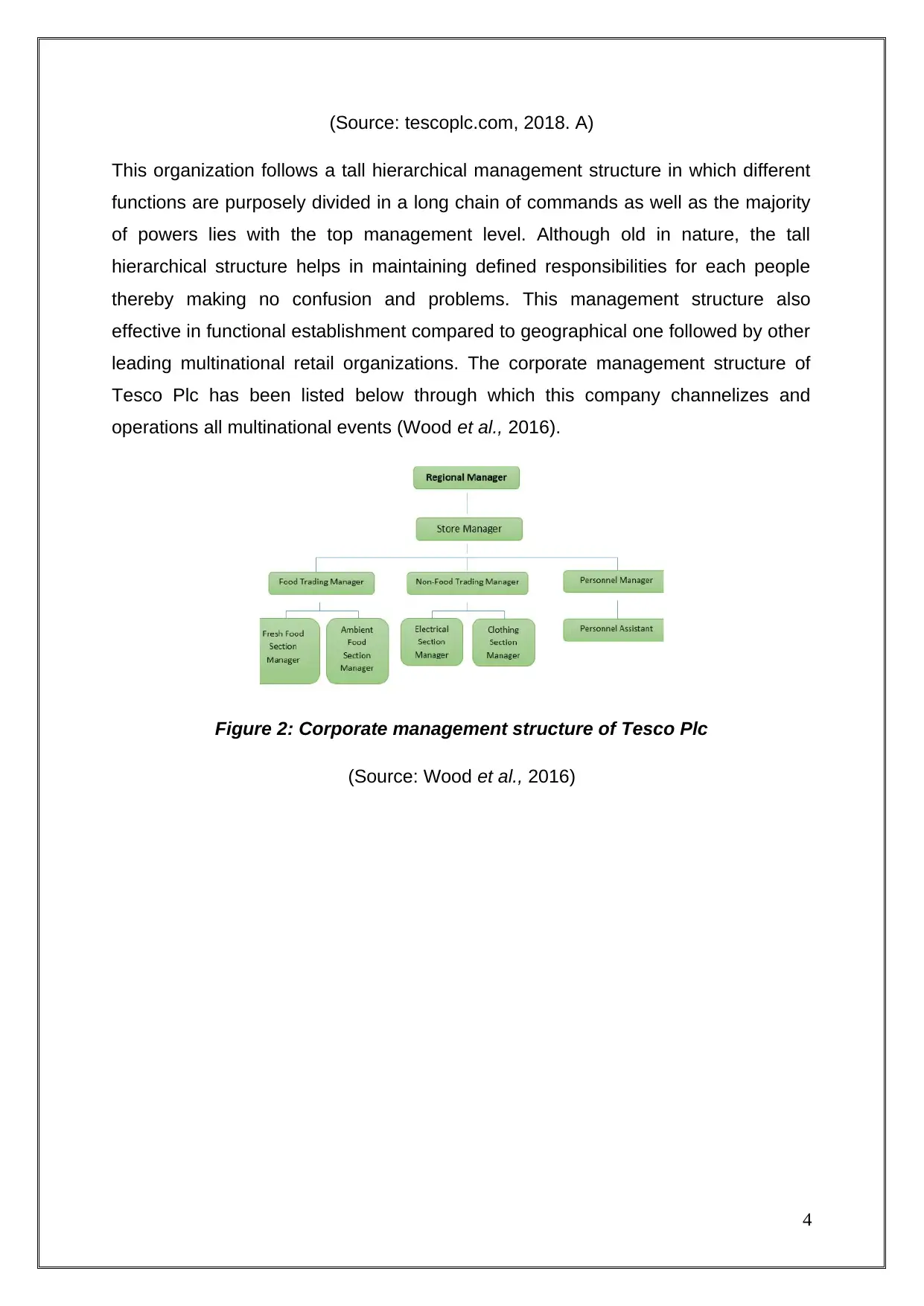
(Source: tescoplc.com, 2018. A)
This organization follows a tall hierarchical management structure in which different
functions are purposely divided in a long chain of commands as well as the majority
of powers lies with the top management level. Although old in nature, the tall
hierarchical structure helps in maintaining defined responsibilities for each people
thereby making no confusion and problems. This management structure also
effective in functional establishment compared to geographical one followed by other
leading multinational retail organizations. The corporate management structure of
Tesco Plc has been listed below through which this company channelizes and
operations all multinational events (Wood et al., 2016).
Figure 2: Corporate management structure of Tesco Plc
(Source: Wood et al., 2016)
4
This organization follows a tall hierarchical management structure in which different
functions are purposely divided in a long chain of commands as well as the majority
of powers lies with the top management level. Although old in nature, the tall
hierarchical structure helps in maintaining defined responsibilities for each people
thereby making no confusion and problems. This management structure also
effective in functional establishment compared to geographical one followed by other
leading multinational retail organizations. The corporate management structure of
Tesco Plc has been listed below through which this company channelizes and
operations all multinational events (Wood et al., 2016).
Figure 2: Corporate management structure of Tesco Plc
(Source: Wood et al., 2016)
4
Paraphrase This Document
Need a fresh take? Get an instant paraphrase of this document with our AI Paraphraser
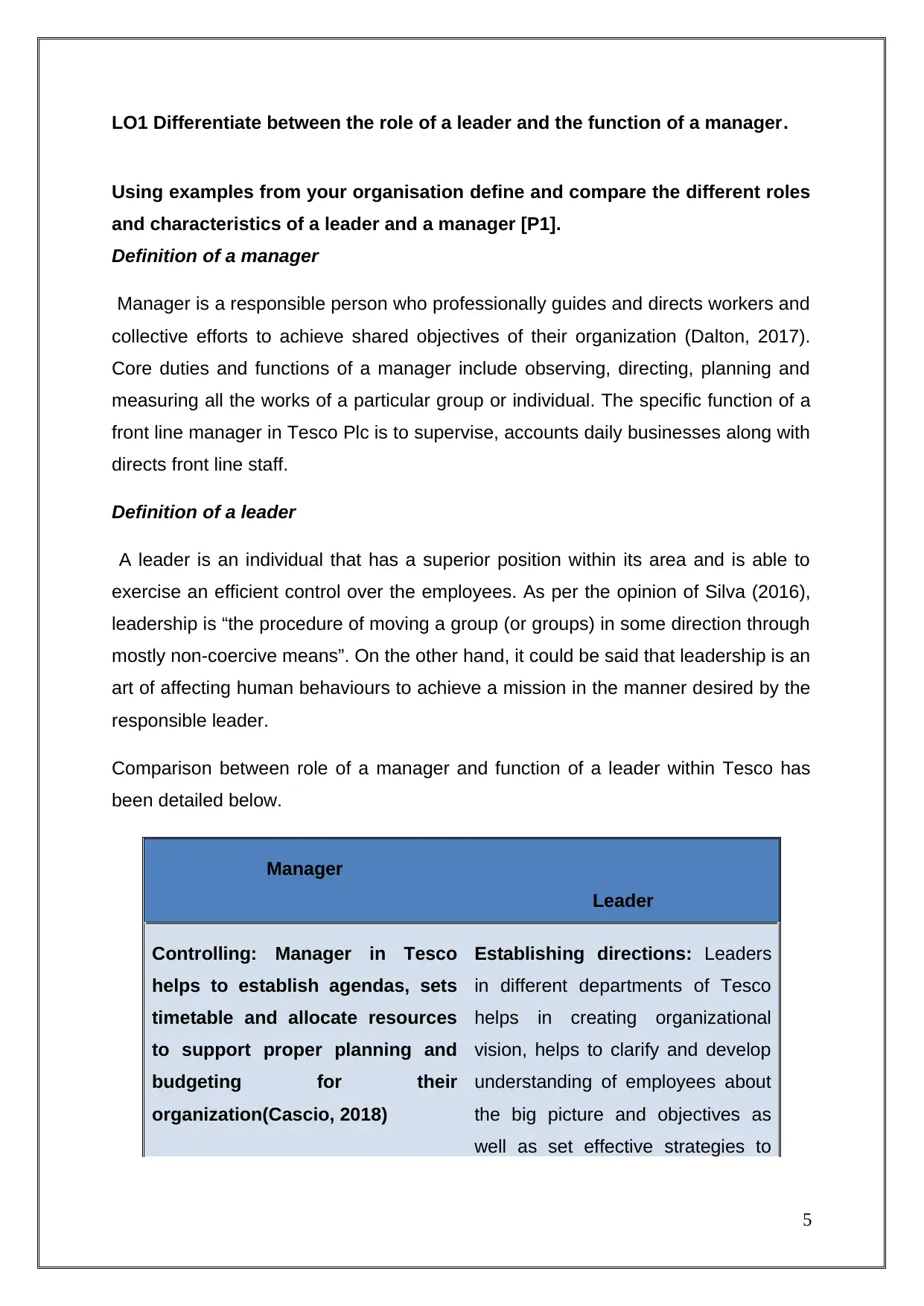
LO1 Differentiate between the role of a leader and the function of a manager.
Using examples from your organisation define and compare the different roles
and characteristics of a leader and a manager [P1].
Definition of a manager
Manager is a responsible person who professionally guides and directs workers and
collective efforts to achieve shared objectives of their organization (Dalton, 2017).
Core duties and functions of a manager include observing, directing, planning and
measuring all the works of a particular group or individual. The specific function of a
front line manager in Tesco Plc is to supervise, accounts daily businesses along with
directs front line staff.
Definition of a leader
A leader is an individual that has a superior position within its area and is able to
exercise an efficient control over the employees. As per the opinion of Silva (2016),
leadership is “the procedure of moving a group (or groups) in some direction through
mostly non-coercive means”. On the other hand, it could be said that leadership is an
art of affecting human behaviours to achieve a mission in the manner desired by the
responsible leader.
Comparison between role of a manager and function of a leader within Tesco has
been detailed below.
Manager
Leader
Controlling: Manager in Tesco
helps to establish agendas, sets
timetable and allocate resources
to support proper planning and
budgeting for their
organization(Cascio, 2018)
Establishing directions: Leaders
in different departments of Tesco
helps in creating organizational
vision, helps to clarify and develop
understanding of employees about
the big picture and objectives as
well as set effective strategies to
5
Using examples from your organisation define and compare the different roles
and characteristics of a leader and a manager [P1].
Definition of a manager
Manager is a responsible person who professionally guides and directs workers and
collective efforts to achieve shared objectives of their organization (Dalton, 2017).
Core duties and functions of a manager include observing, directing, planning and
measuring all the works of a particular group or individual. The specific function of a
front line manager in Tesco Plc is to supervise, accounts daily businesses along with
directs front line staff.
Definition of a leader
A leader is an individual that has a superior position within its area and is able to
exercise an efficient control over the employees. As per the opinion of Silva (2016),
leadership is “the procedure of moving a group (or groups) in some direction through
mostly non-coercive means”. On the other hand, it could be said that leadership is an
art of affecting human behaviours to achieve a mission in the manner desired by the
responsible leader.
Comparison between role of a manager and function of a leader within Tesco has
been detailed below.
Manager
Leader
Controlling: Manager in Tesco
helps to establish agendas, sets
timetable and allocate resources
to support proper planning and
budgeting for their
organization(Cascio, 2018)
Establishing directions: Leaders
in different departments of Tesco
helps in creating organizational
vision, helps to clarify and develop
understanding of employees about
the big picture and objectives as
well as set effective strategies to
5
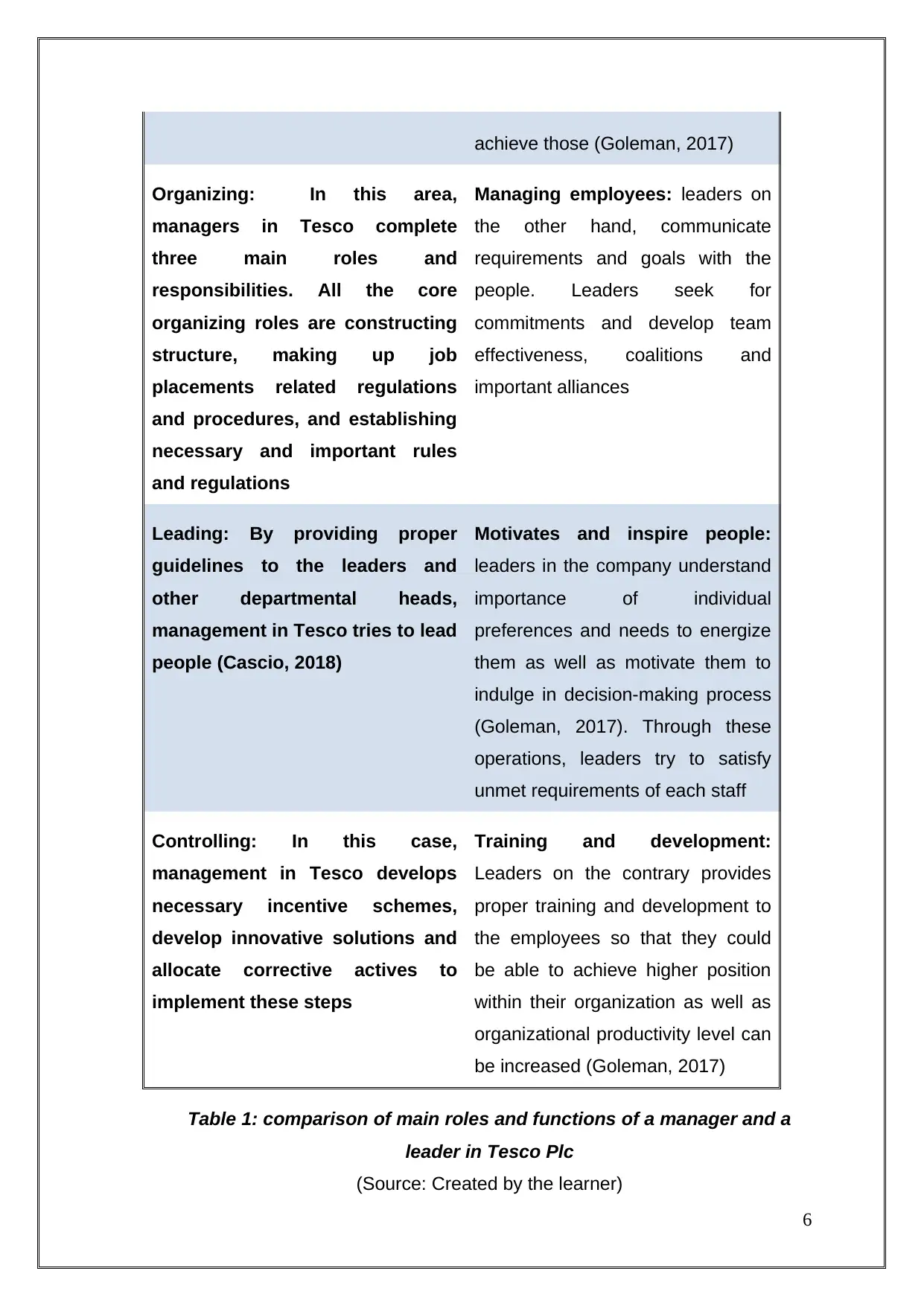
achieve those (Goleman, 2017)
Organizing: In this area,
managers in Tesco complete
three main roles and
responsibilities. All the core
organizing roles are constructing
structure, making up job
placements related regulations
and procedures, and establishing
necessary and important rules
and regulations
Managing employees: leaders on
the other hand, communicate
requirements and goals with the
people. Leaders seek for
commitments and develop team
effectiveness, coalitions and
important alliances
Leading: By providing proper
guidelines to the leaders and
other departmental heads,
management in Tesco tries to lead
people (Cascio, 2018)
Motivates and inspire people:
leaders in the company understand
importance of individual
preferences and needs to energize
them as well as motivate them to
indulge in decision-making process
(Goleman, 2017). Through these
operations, leaders try to satisfy
unmet requirements of each staff
Controlling: In this case,
management in Tesco develops
necessary incentive schemes,
develop innovative solutions and
allocate corrective actives to
implement these steps
Training and development:
Leaders on the contrary provides
proper training and development to
the employees so that they could
be able to achieve higher position
within their organization as well as
organizational productivity level can
be increased (Goleman, 2017)
Table 1: comparison of main roles and functions of a manager and a
leader in Tesco Plc
(Source: Created by the learner)
6
Organizing: In this area,
managers in Tesco complete
three main roles and
responsibilities. All the core
organizing roles are constructing
structure, making up job
placements related regulations
and procedures, and establishing
necessary and important rules
and regulations
Managing employees: leaders on
the other hand, communicate
requirements and goals with the
people. Leaders seek for
commitments and develop team
effectiveness, coalitions and
important alliances
Leading: By providing proper
guidelines to the leaders and
other departmental heads,
management in Tesco tries to lead
people (Cascio, 2018)
Motivates and inspire people:
leaders in the company understand
importance of individual
preferences and needs to energize
them as well as motivate them to
indulge in decision-making process
(Goleman, 2017). Through these
operations, leaders try to satisfy
unmet requirements of each staff
Controlling: In this case,
management in Tesco develops
necessary incentive schemes,
develop innovative solutions and
allocate corrective actives to
implement these steps
Training and development:
Leaders on the contrary provides
proper training and development to
the employees so that they could
be able to achieve higher position
within their organization as well as
organizational productivity level can
be increased (Goleman, 2017)
Table 1: comparison of main roles and functions of a manager and a
leader in Tesco Plc
(Source: Created by the learner)
6
⊘ This is a preview!⊘
Do you want full access?
Subscribe today to unlock all pages.

Trusted by 1+ million students worldwide
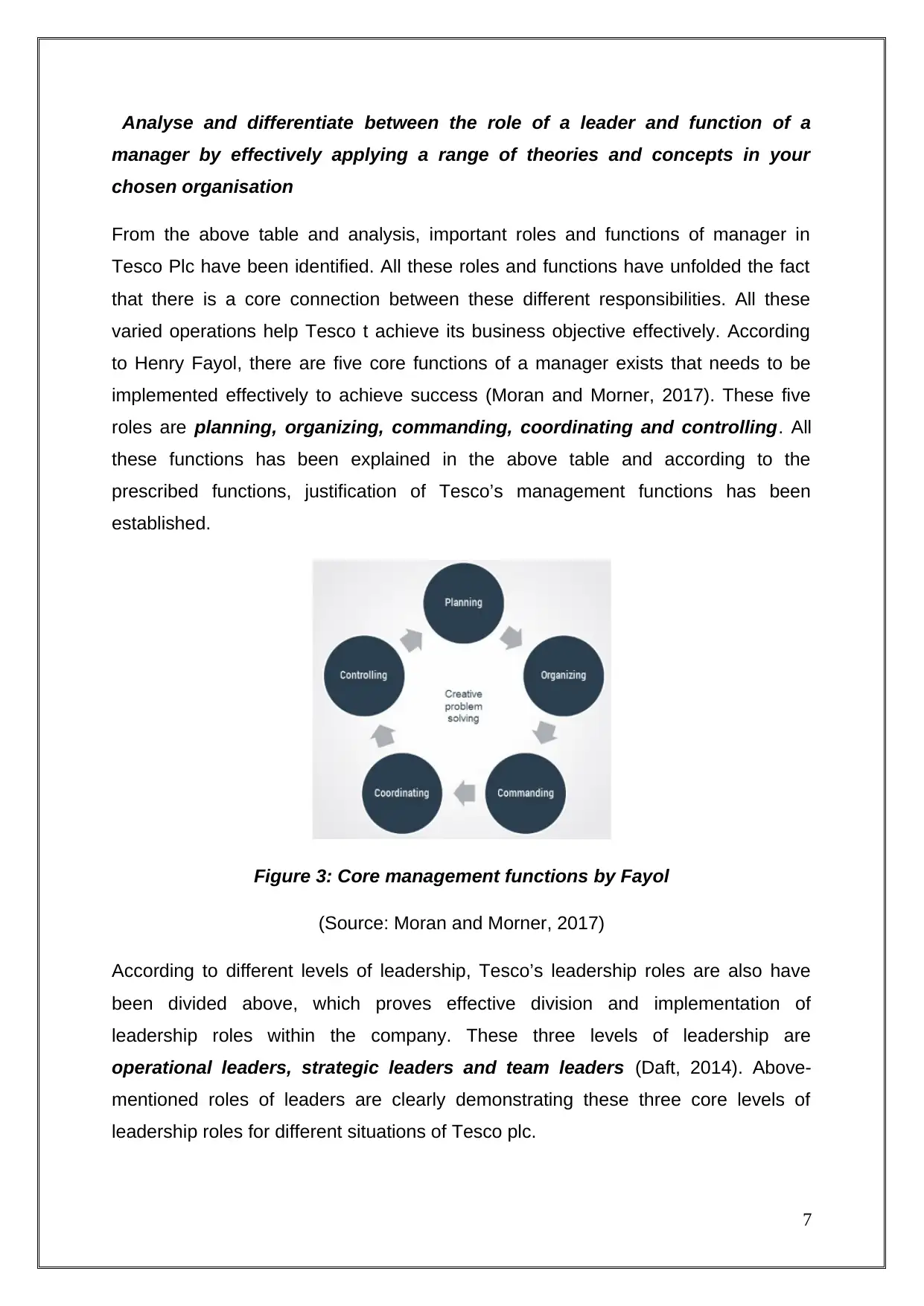
Analyse and differentiate between the role of a leader and function of a
manager by effectively applying a range of theories and concepts in your
chosen organisation
From the above table and analysis, important roles and functions of manager in
Tesco Plc have been identified. All these roles and functions have unfolded the fact
that there is a core connection between these different responsibilities. All these
varied operations help Tesco t achieve its business objective effectively. According
to Henry Fayol, there are five core functions of a manager exists that needs to be
implemented effectively to achieve success (Moran and Morner, 2017). These five
roles are planning, organizing, commanding, coordinating and controlling. All
these functions has been explained in the above table and according to the
prescribed functions, justification of Tesco’s management functions has been
established.
Figure 3: Core management functions by Fayol
(Source: Moran and Morner, 2017)
According to different levels of leadership, Tesco’s leadership roles are also have
been divided above, which proves effective division and implementation of
leadership roles within the company. These three levels of leadership are
operational leaders, strategic leaders and team leaders (Daft, 2014). Above-
mentioned roles of leaders are clearly demonstrating these three core levels of
leadership roles for different situations of Tesco plc.
7
manager by effectively applying a range of theories and concepts in your
chosen organisation
From the above table and analysis, important roles and functions of manager in
Tesco Plc have been identified. All these roles and functions have unfolded the fact
that there is a core connection between these different responsibilities. All these
varied operations help Tesco t achieve its business objective effectively. According
to Henry Fayol, there are five core functions of a manager exists that needs to be
implemented effectively to achieve success (Moran and Morner, 2017). These five
roles are planning, organizing, commanding, coordinating and controlling. All
these functions has been explained in the above table and according to the
prescribed functions, justification of Tesco’s management functions has been
established.
Figure 3: Core management functions by Fayol
(Source: Moran and Morner, 2017)
According to different levels of leadership, Tesco’s leadership roles are also have
been divided above, which proves effective division and implementation of
leadership roles within the company. These three levels of leadership are
operational leaders, strategic leaders and team leaders (Daft, 2014). Above-
mentioned roles of leaders are clearly demonstrating these three core levels of
leadership roles for different situations of Tesco plc.
7
Paraphrase This Document
Need a fresh take? Get an instant paraphrase of this document with our AI Paraphraser
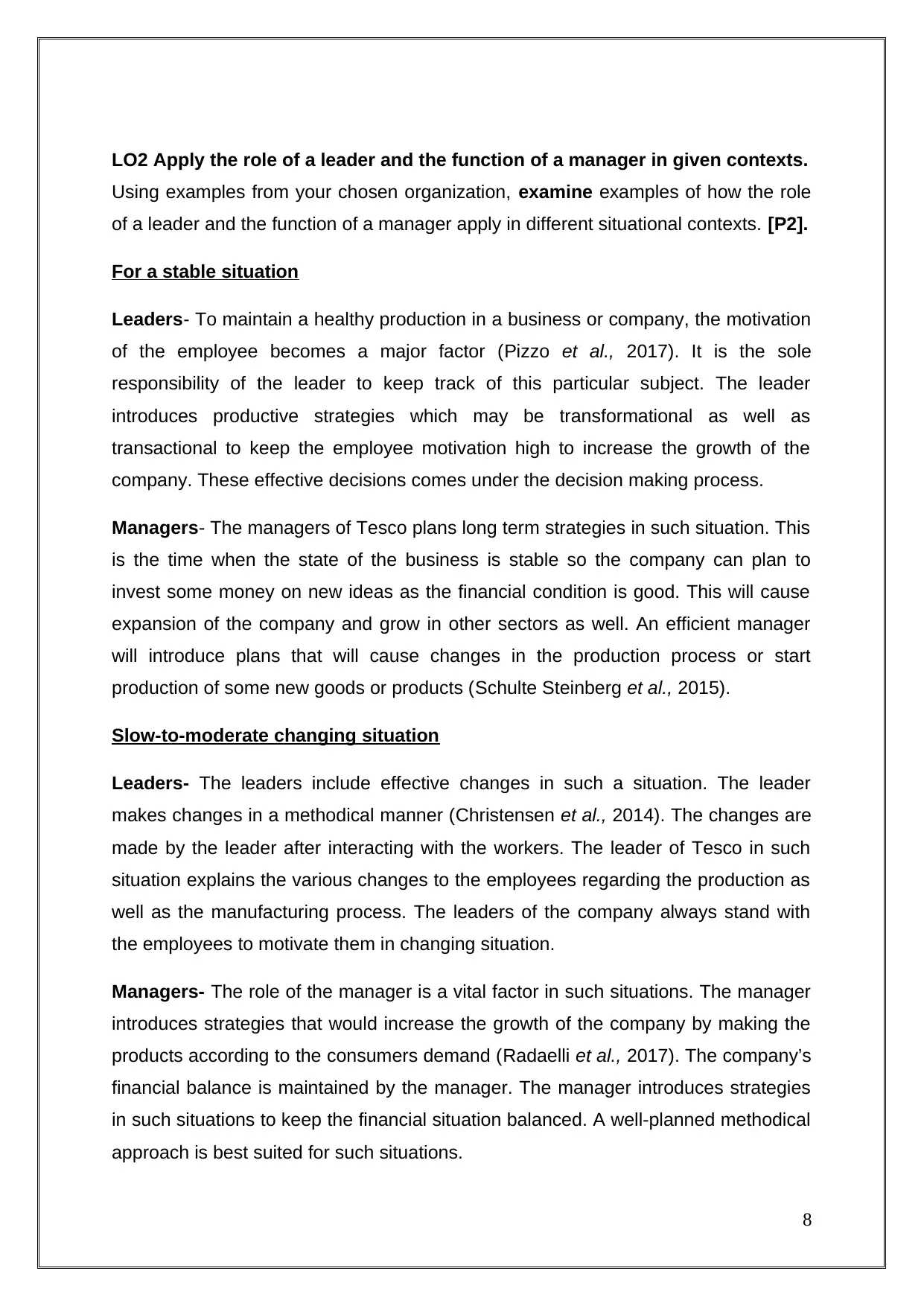
LO2 Apply the role of a leader and the function of a manager in given contexts.
Using examples from your chosen organization, examine examples of how the role
of a leader and the function of a manager apply in different situational contexts. [P2].
For a stable situation
Leaders- To maintain a healthy production in a business or company, the motivation
of the employee becomes a major factor (Pizzo et al., 2017). It is the sole
responsibility of the leader to keep track of this particular subject. The leader
introduces productive strategies which may be transformational as well as
transactional to keep the employee motivation high to increase the growth of the
company. These effective decisions comes under the decision making process.
Managers- The managers of Tesco plans long term strategies in such situation. This
is the time when the state of the business is stable so the company can plan to
invest some money on new ideas as the financial condition is good. This will cause
expansion of the company and grow in other sectors as well. An efficient manager
will introduce plans that will cause changes in the production process or start
production of some new goods or products (Schulte Steinberg et al., 2015).
Slow-to-moderate changing situation
Leaders- The leaders include effective changes in such a situation. The leader
makes changes in a methodical manner (Christensen et al., 2014). The changes are
made by the leader after interacting with the workers. The leader of Tesco in such
situation explains the various changes to the employees regarding the production as
well as the manufacturing process. The leaders of the company always stand with
the employees to motivate them in changing situation.
Managers- The role of the manager is a vital factor in such situations. The manager
introduces strategies that would increase the growth of the company by making the
products according to the consumers demand (Radaelli et al., 2017). The company’s
financial balance is maintained by the manager. The manager introduces strategies
in such situations to keep the financial situation balanced. A well-planned methodical
approach is best suited for such situations.
8
Using examples from your chosen organization, examine examples of how the role
of a leader and the function of a manager apply in different situational contexts. [P2].
For a stable situation
Leaders- To maintain a healthy production in a business or company, the motivation
of the employee becomes a major factor (Pizzo et al., 2017). It is the sole
responsibility of the leader to keep track of this particular subject. The leader
introduces productive strategies which may be transformational as well as
transactional to keep the employee motivation high to increase the growth of the
company. These effective decisions comes under the decision making process.
Managers- The managers of Tesco plans long term strategies in such situation. This
is the time when the state of the business is stable so the company can plan to
invest some money on new ideas as the financial condition is good. This will cause
expansion of the company and grow in other sectors as well. An efficient manager
will introduce plans that will cause changes in the production process or start
production of some new goods or products (Schulte Steinberg et al., 2015).
Slow-to-moderate changing situation
Leaders- The leaders include effective changes in such a situation. The leader
makes changes in a methodical manner (Christensen et al., 2014). The changes are
made by the leader after interacting with the workers. The leader of Tesco in such
situation explains the various changes to the employees regarding the production as
well as the manufacturing process. The leaders of the company always stand with
the employees to motivate them in changing situation.
Managers- The role of the manager is a vital factor in such situations. The manager
introduces strategies that would increase the growth of the company by making the
products according to the consumers demand (Radaelli et al., 2017). The company’s
financial balance is maintained by the manager. The manager introduces strategies
in such situations to keep the financial situation balanced. A well-planned methodical
approach is best suited for such situations.
8
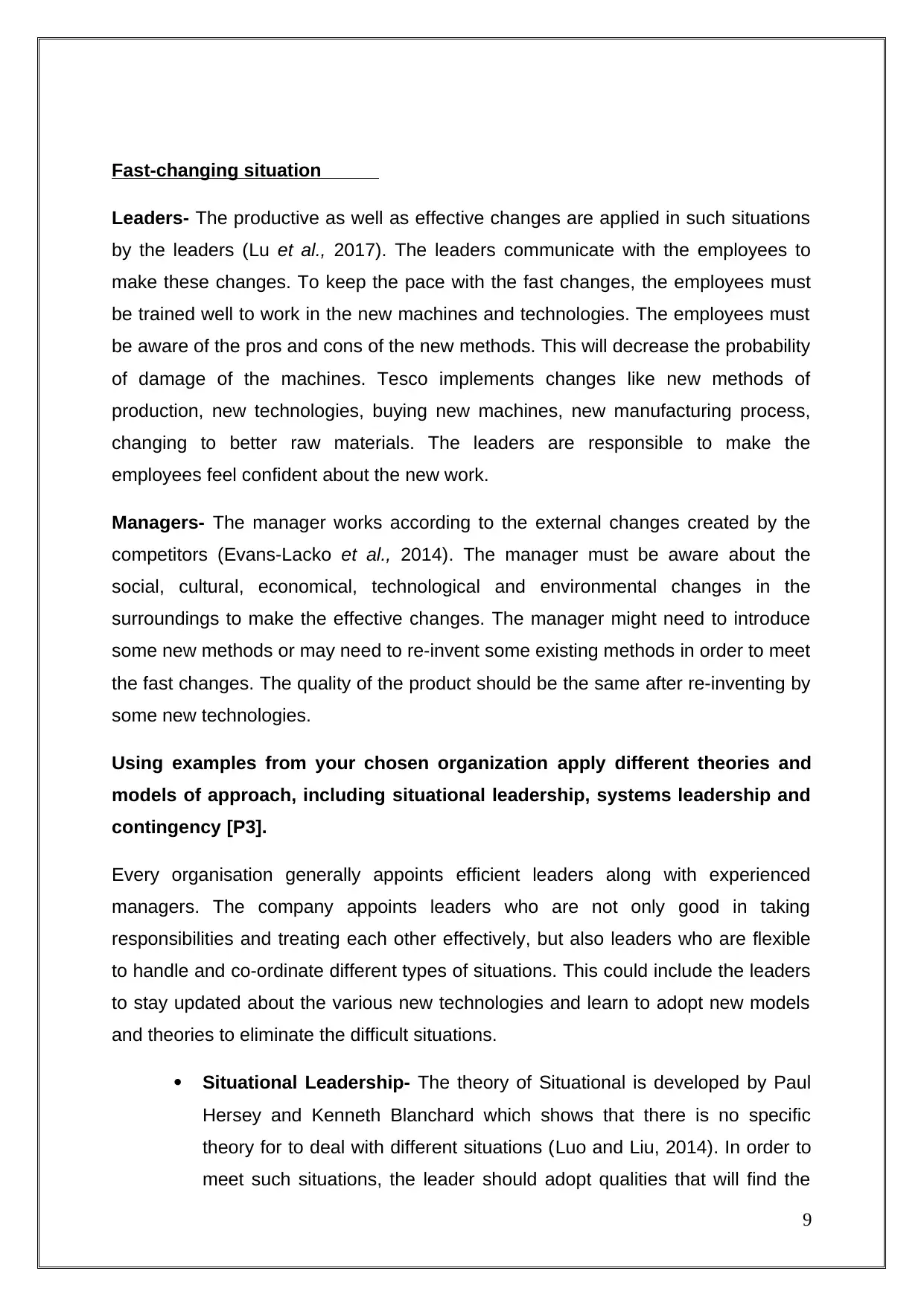
Fast-changing situation
Leaders- The productive as well as effective changes are applied in such situations
by the leaders (Lu et al., 2017). The leaders communicate with the employees to
make these changes. To keep the pace with the fast changes, the employees must
be trained well to work in the new machines and technologies. The employees must
be aware of the pros and cons of the new methods. This will decrease the probability
of damage of the machines. Tesco implements changes like new methods of
production, new technologies, buying new machines, new manufacturing process,
changing to better raw materials. The leaders are responsible to make the
employees feel confident about the new work.
Managers- The manager works according to the external changes created by the
competitors (Evans-Lacko et al., 2014). The manager must be aware about the
social, cultural, economical, technological and environmental changes in the
surroundings to make the effective changes. The manager might need to introduce
some new methods or may need to re-invent some existing methods in order to meet
the fast changes. The quality of the product should be the same after re-inventing by
some new technologies.
Using examples from your chosen organization apply different theories and
models of approach, including situational leadership, systems leadership and
contingency [P3].
Every organisation generally appoints efficient leaders along with experienced
managers. The company appoints leaders who are not only good in taking
responsibilities and treating each other effectively, but also leaders who are flexible
to handle and co-ordinate different types of situations. This could include the leaders
to stay updated about the various new technologies and learn to adopt new models
and theories to eliminate the difficult situations.
Situational Leadership- The theory of Situational is developed by Paul
Hersey and Kenneth Blanchard which shows that there is no specific
theory for to deal with different situations (Luo and Liu, 2014). In order to
meet such situations, the leader should adopt qualities that will find the
9
Leaders- The productive as well as effective changes are applied in such situations
by the leaders (Lu et al., 2017). The leaders communicate with the employees to
make these changes. To keep the pace with the fast changes, the employees must
be trained well to work in the new machines and technologies. The employees must
be aware of the pros and cons of the new methods. This will decrease the probability
of damage of the machines. Tesco implements changes like new methods of
production, new technologies, buying new machines, new manufacturing process,
changing to better raw materials. The leaders are responsible to make the
employees feel confident about the new work.
Managers- The manager works according to the external changes created by the
competitors (Evans-Lacko et al., 2014). The manager must be aware about the
social, cultural, economical, technological and environmental changes in the
surroundings to make the effective changes. The manager might need to introduce
some new methods or may need to re-invent some existing methods in order to meet
the fast changes. The quality of the product should be the same after re-inventing by
some new technologies.
Using examples from your chosen organization apply different theories and
models of approach, including situational leadership, systems leadership and
contingency [P3].
Every organisation generally appoints efficient leaders along with experienced
managers. The company appoints leaders who are not only good in taking
responsibilities and treating each other effectively, but also leaders who are flexible
to handle and co-ordinate different types of situations. This could include the leaders
to stay updated about the various new technologies and learn to adopt new models
and theories to eliminate the difficult situations.
Situational Leadership- The theory of Situational is developed by Paul
Hersey and Kenneth Blanchard which shows that there is no specific
theory for to deal with different situations (Luo and Liu, 2014). In order to
meet such situations, the leader should adopt qualities that will find the
9
⊘ This is a preview!⊘
Do you want full access?
Subscribe today to unlock all pages.

Trusted by 1+ million students worldwide
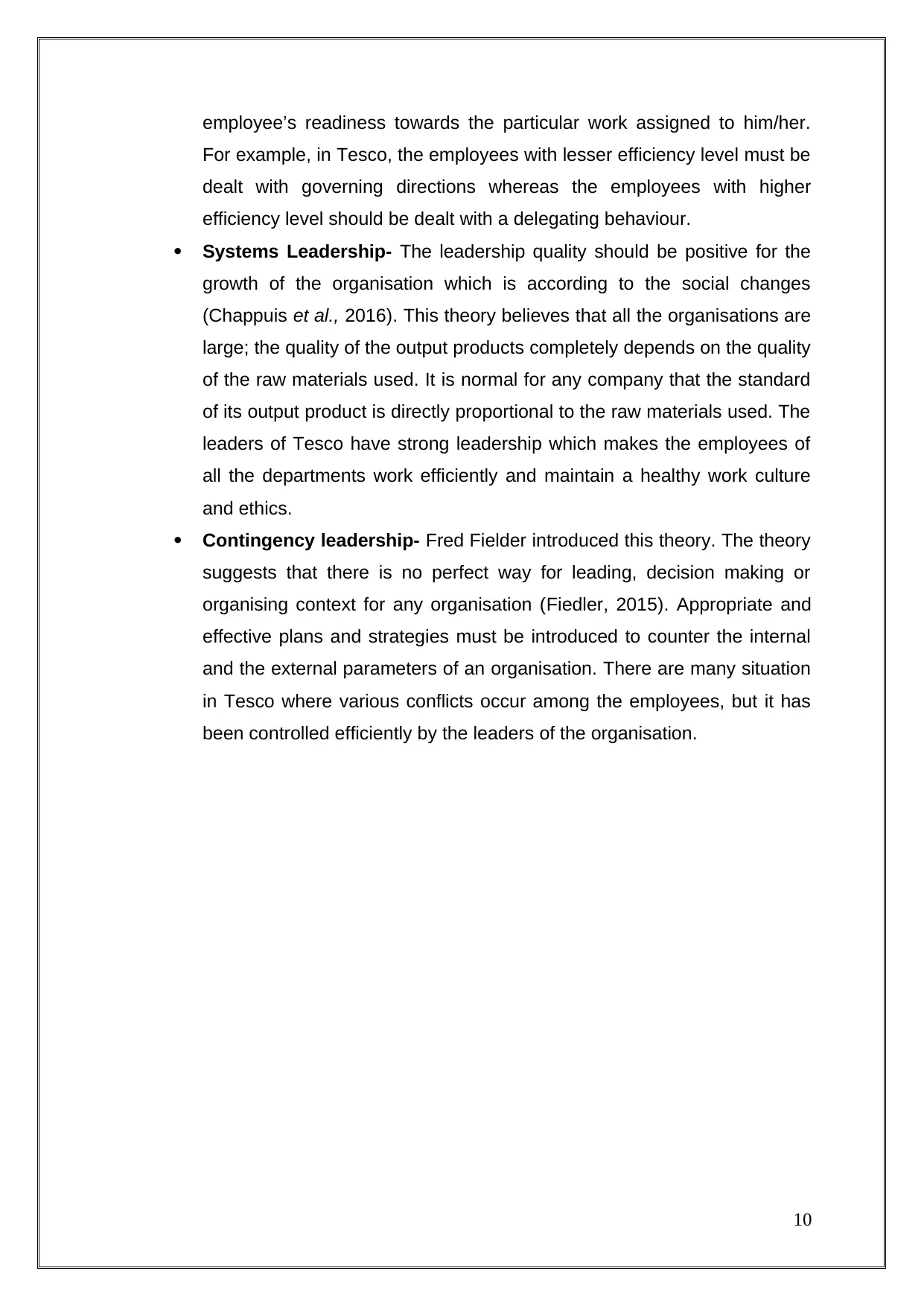
employee’s readiness towards the particular work assigned to him/her.
For example, in Tesco, the employees with lesser efficiency level must be
dealt with governing directions whereas the employees with higher
efficiency level should be dealt with a delegating behaviour.
Systems Leadership- The leadership quality should be positive for the
growth of the organisation which is according to the social changes
(Chappuis et al., 2016). This theory believes that all the organisations are
large; the quality of the output products completely depends on the quality
of the raw materials used. It is normal for any company that the standard
of its output product is directly proportional to the raw materials used. The
leaders of Tesco have strong leadership which makes the employees of
all the departments work efficiently and maintain a healthy work culture
and ethics.
Contingency leadership- Fred Fielder introduced this theory. The theory
suggests that there is no perfect way for leading, decision making or
organising context for any organisation (Fiedler, 2015). Appropriate and
effective plans and strategies must be introduced to counter the internal
and the external parameters of an organisation. There are many situation
in Tesco where various conflicts occur among the employees, but it has
been controlled efficiently by the leaders of the organisation.
10
For example, in Tesco, the employees with lesser efficiency level must be
dealt with governing directions whereas the employees with higher
efficiency level should be dealt with a delegating behaviour.
Systems Leadership- The leadership quality should be positive for the
growth of the organisation which is according to the social changes
(Chappuis et al., 2016). This theory believes that all the organisations are
large; the quality of the output products completely depends on the quality
of the raw materials used. It is normal for any company that the standard
of its output product is directly proportional to the raw materials used. The
leaders of Tesco have strong leadership which makes the employees of
all the departments work efficiently and maintain a healthy work culture
and ethics.
Contingency leadership- Fred Fielder introduced this theory. The theory
suggests that there is no perfect way for leading, decision making or
organising context for any organisation (Fiedler, 2015). Appropriate and
effective plans and strategies must be introduced to counter the internal
and the external parameters of an organisation. There are many situation
in Tesco where various conflicts occur among the employees, but it has
been controlled efficiently by the leaders of the organisation.
10
Paraphrase This Document
Need a fresh take? Get an instant paraphrase of this document with our AI Paraphraser
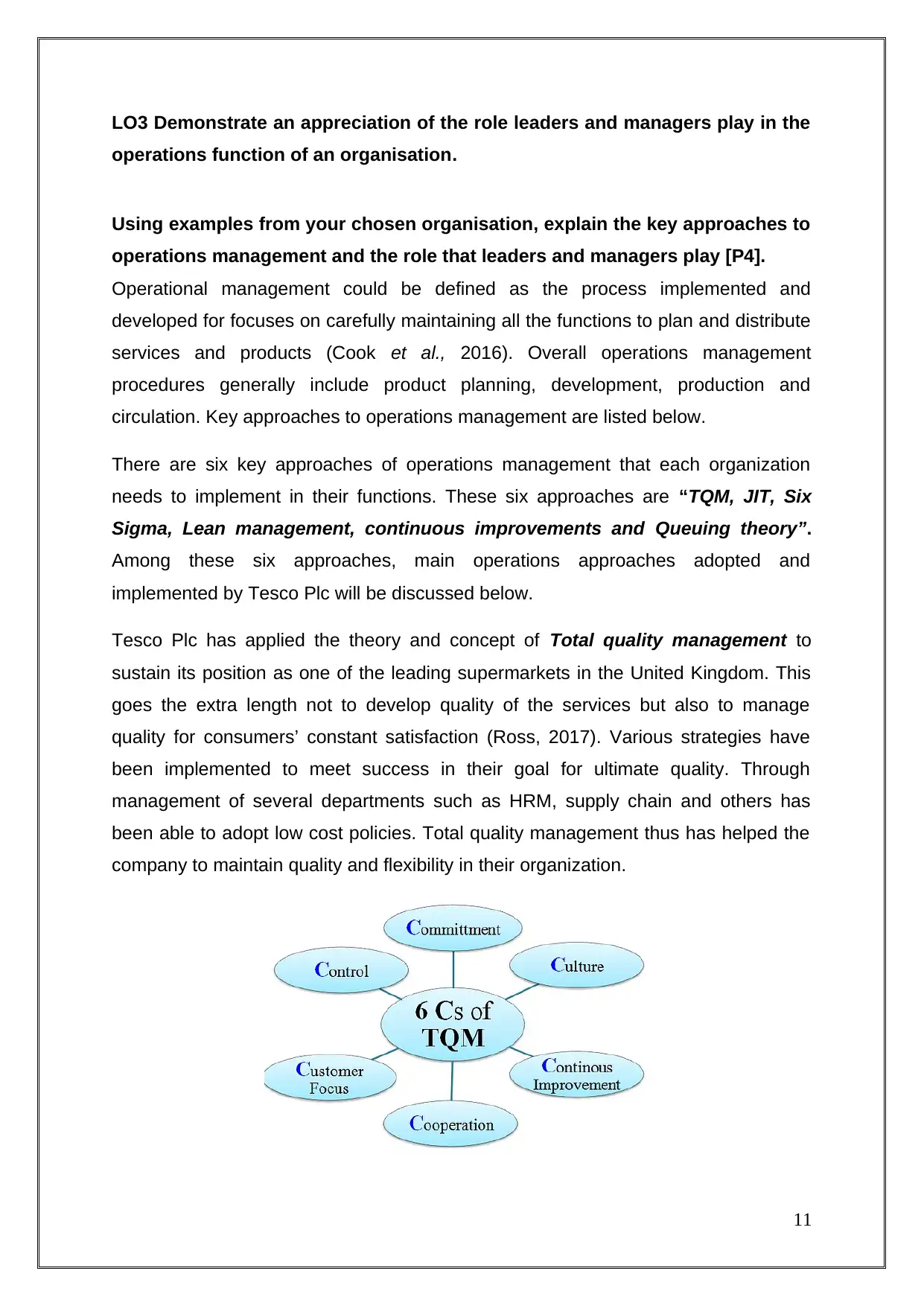
LO3 Demonstrate an appreciation of the role leaders and managers play in the
operations function of an organisation.
Using examples from your chosen organisation, explain the key approaches to
operations management and the role that leaders and managers play [P4].
Operational management could be defined as the process implemented and
developed for focuses on carefully maintaining all the functions to plan and distribute
services and products (Cook et al., 2016). Overall operations management
procedures generally include product planning, development, production and
circulation. Key approaches to operations management are listed below.
There are six key approaches of operations management that each organization
needs to implement in their functions. These six approaches are “TQM, JIT, Six
Sigma, Lean management, continuous improvements and Queuing theory”.
Among these six approaches, main operations approaches adopted and
implemented by Tesco Plc will be discussed below.
Tesco Plc has applied the theory and concept of Total quality management to
sustain its position as one of the leading supermarkets in the United Kingdom. This
goes the extra length not to develop quality of the services but also to manage
quality for consumers’ constant satisfaction (Ross, 2017). Various strategies have
been implemented to meet success in their goal for ultimate quality. Through
management of several departments such as HRM, supply chain and others has
been able to adopt low cost policies. Total quality management thus has helped the
company to maintain quality and flexibility in their organization.
11
operations function of an organisation.
Using examples from your chosen organisation, explain the key approaches to
operations management and the role that leaders and managers play [P4].
Operational management could be defined as the process implemented and
developed for focuses on carefully maintaining all the functions to plan and distribute
services and products (Cook et al., 2016). Overall operations management
procedures generally include product planning, development, production and
circulation. Key approaches to operations management are listed below.
There are six key approaches of operations management that each organization
needs to implement in their functions. These six approaches are “TQM, JIT, Six
Sigma, Lean management, continuous improvements and Queuing theory”.
Among these six approaches, main operations approaches adopted and
implemented by Tesco Plc will be discussed below.
Tesco Plc has applied the theory and concept of Total quality management to
sustain its position as one of the leading supermarkets in the United Kingdom. This
goes the extra length not to develop quality of the services but also to manage
quality for consumers’ constant satisfaction (Ross, 2017). Various strategies have
been implemented to meet success in their goal for ultimate quality. Through
management of several departments such as HRM, supply chain and others has
been able to adopt low cost policies. Total quality management thus has helped the
company to maintain quality and flexibility in their organization.
11
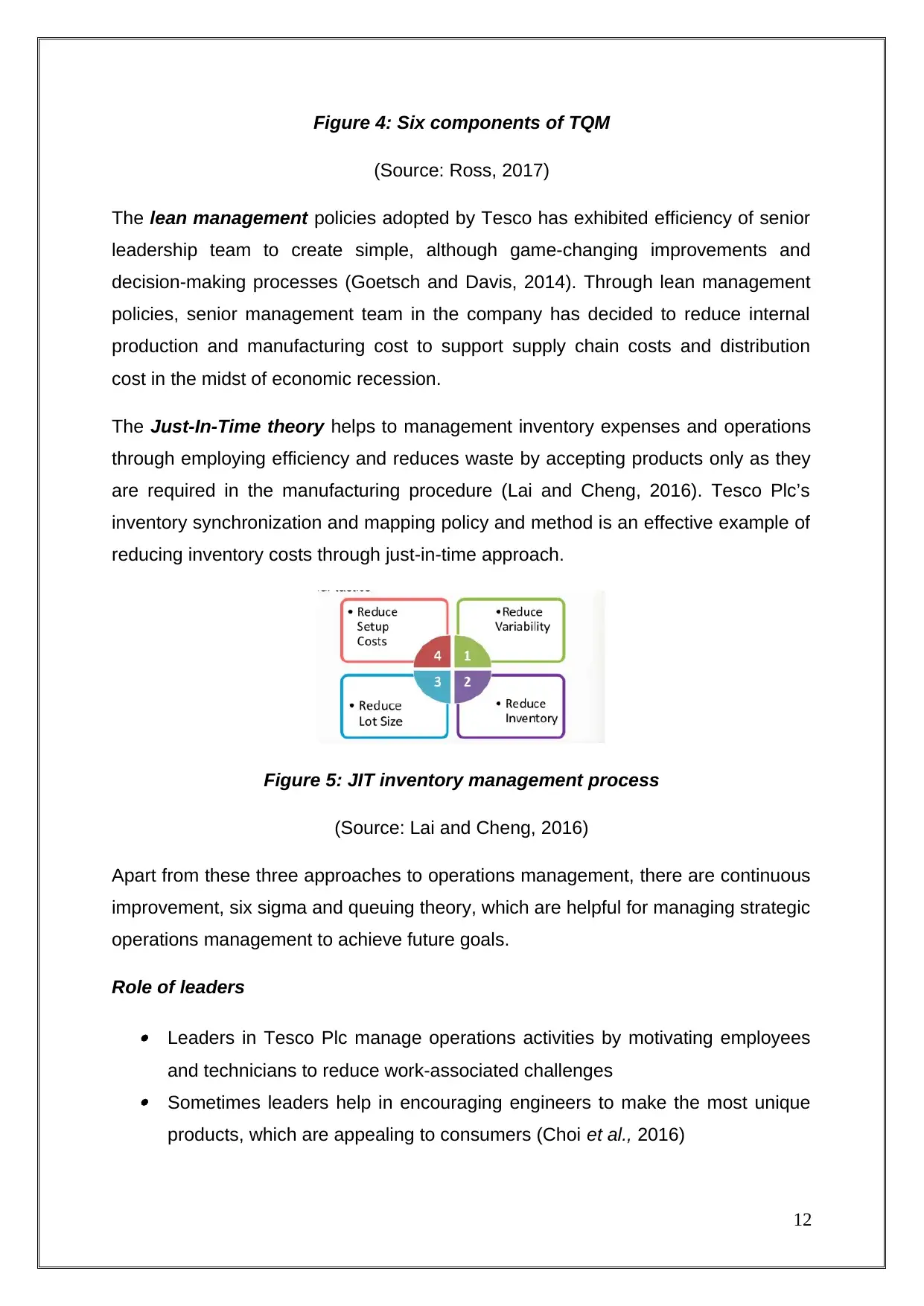
Figure 4: Six components of TQM
(Source: Ross, 2017)
The lean management policies adopted by Tesco has exhibited efficiency of senior
leadership team to create simple, although game-changing improvements and
decision-making processes (Goetsch and Davis, 2014). Through lean management
policies, senior management team in the company has decided to reduce internal
production and manufacturing cost to support supply chain costs and distribution
cost in the midst of economic recession.
The Just-In-Time theory helps to management inventory expenses and operations
through employing efficiency and reduces waste by accepting products only as they
are required in the manufacturing procedure (Lai and Cheng, 2016). Tesco Plc’s
inventory synchronization and mapping policy and method is an effective example of
reducing inventory costs through just-in-time approach.
Figure 5: JIT inventory management process
(Source: Lai and Cheng, 2016)
Apart from these three approaches to operations management, there are continuous
improvement, six sigma and queuing theory, which are helpful for managing strategic
operations management to achieve future goals.
Role of leaders
Leaders in Tesco Plc manage operations activities by motivating employees
and technicians to reduce work-associated challenges Sometimes leaders help in encouraging engineers to make the most unique
products, which are appealing to consumers (Choi et al., 2016)
12
(Source: Ross, 2017)
The lean management policies adopted by Tesco has exhibited efficiency of senior
leadership team to create simple, although game-changing improvements and
decision-making processes (Goetsch and Davis, 2014). Through lean management
policies, senior management team in the company has decided to reduce internal
production and manufacturing cost to support supply chain costs and distribution
cost in the midst of economic recession.
The Just-In-Time theory helps to management inventory expenses and operations
through employing efficiency and reduces waste by accepting products only as they
are required in the manufacturing procedure (Lai and Cheng, 2016). Tesco Plc’s
inventory synchronization and mapping policy and method is an effective example of
reducing inventory costs through just-in-time approach.
Figure 5: JIT inventory management process
(Source: Lai and Cheng, 2016)
Apart from these three approaches to operations management, there are continuous
improvement, six sigma and queuing theory, which are helpful for managing strategic
operations management to achieve future goals.
Role of leaders
Leaders in Tesco Plc manage operations activities by motivating employees
and technicians to reduce work-associated challenges Sometimes leaders help in encouraging engineers to make the most unique
products, which are appealing to consumers (Choi et al., 2016)
12
⊘ This is a preview!⊘
Do you want full access?
Subscribe today to unlock all pages.

Trusted by 1+ million students worldwide
1 out of 20
Related Documents
Your All-in-One AI-Powered Toolkit for Academic Success.
+13062052269
info@desklib.com
Available 24*7 on WhatsApp / Email
![[object Object]](/_next/static/media/star-bottom.7253800d.svg)
Unlock your academic potential
Copyright © 2020–2025 A2Z Services. All Rights Reserved. Developed and managed by ZUCOL.




